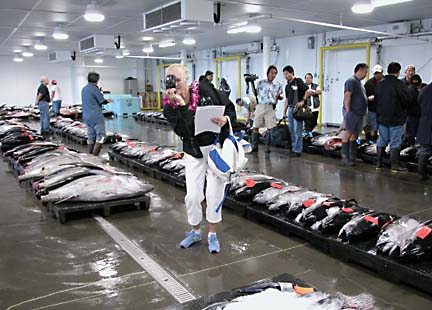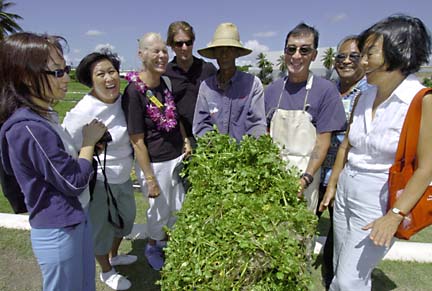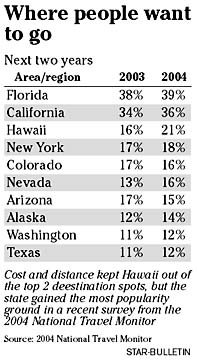

|
Off the
beaten path
Tourists now want to find a way
to get more out of their vacation than
laying in the sun. Hawaii businesses
are capitalizing on the growing trend
Alina Kracke, of Seattle is already so in love with Hawaii's beauty and beaches that she's visited the destination more than 30 times.
She got back on a plane this week to come explore Hawaii's cuisine at the Halekulani's new $600 culinary tour.
"I was looking for a hands-on experience," Kracke said. "I've been to Hawaii many times, but I was excited about going on this tour because the people here are very special and there is so much knowledge that they can impart."
The Art of Hawaiian Cuisine, hosted by cookbook author Joan Namkoong, is a two-day feast of the senses that winds through the United Fishing Agency, the Oahu Market in Chinatown, Sumida's Watercress Farm in Aiea and La Mer's kitchen at Halekulani.
Along the way travelers get a glimpse of the ethnic diversity and spirit of Hawaii's people, a chance to sample culinary delights, and the opportunity to learn cooking tips.
In Hawaii, as in other destinations, tourists are demonstrating that they have a taste for the well-seasoned vacation, chock full of exotic experiences that enrich the palate and add a little spice to their lives.
|
A recent study from the Travel Industry Association of America and Smithsonian Magazine shows growing interest in travelers' desire to explore culture, arts, history and heritage activities.
The study said 81 percent of U.S. adults who traveled in the past year, or 118 million, consider themselves historical/cultural travelers. These travelers went on almost 217 million trips last year, up 13 percent from 1996.
"The sheer volume of travelers interested in arts and history, as well as their spending habits, their travel patterns and demographics, leaves no doubt that history and culture continue to be a significant and growing part of the U.S. travel experience," said William S. Norman, president and chief executive of the Travel Industry Association of America.
The Halekulani's culinary tour is one example of how the state's visitor industry is capitalizing on this trend by developing new activities that spotlight Hawaii's culture, arts and history, Wienert said.
The state is attempting to entice tourists to come during softer travel periods through programs like the ongoing Aloha Festivals, the Hawaii Arts Season and the Aloha Live! music tour.
Activity providers are changing their products or developing new ones to respond to visitor demand, said Toni Marie Davis, executive director of the Activities & Attractions Association of Hawaii.
"More and more visitors want to come away from an activity enriched and improved as a person," Davis said, adding that growth in the industry prompted her to hire three more employees.

|
More businesses are also benefiting from tourism's trickle-down effect, Wienert said.
Tourists are flocking to Sumida's Watercress Farm in Aiea, said David Sumida, whose grandfather opened the farm in 1928.
Japan travelers, armed with a map of the farm, come to collect water from the spring that nourishes the watercress, Sumida said.
The explosion of Pacific Rim cuisine has also prompted chefs from all over the world to visit the farm, Sumida said.
"They come from places like Italy, France and Germany and they all tell us Hawaii's watercress is the best," he said.
 The demand for more in-depth tourism products encouraged former restaurant critic Matthew Gray to launch Hawaii Food Tours last month. The company, which offers guided restaurant tours, satisfies a craving in the market for sophisticated travel experiences, Gray said.
The demand for more in-depth tourism products encouraged former restaurant critic Matthew Gray to launch Hawaii Food Tours last month. The company, which offers guided restaurant tours, satisfies a craving in the market for sophisticated travel experiences, Gray said.
"From a business perspective, it seemed like the time was right," Gray said. "Many travelers are tired of the same old, same old. They are looking for an opportunity to have a really wonderful social experience that goes beyond the guidebooks."
While travelers were more cautious in the aftermath of 9/11, their sense of exploration and adventure has returned, said Peter Yesowich, a researcher and consultant who also produces the National Travel Monitor newsletter.
"There's a yearning on the part of people to bring home something more than a tan," Yesowich said. "They want some residual memory or experience that they can reflect on that was truly unique as part of their vacation."
That's why preserving and showcasing the Hawaiian culture is the most important element in attracting visitors to Hawaii, said Jim Austin, spokesman for Outrigger Hotels & Resorts.
Outrigger is encouraging guests take surfing classes, catch a canoe ride, make a lei, or learn the art of herbal healing.
Guests at the Outrigger Waikiki Hotel can view ancient Hawaiian artifacts on the property such as a rare sperm whale-tooth necklace, a poi pounder or a squid catcher. Twice a week, married couples can also renew their wedding vows in a Hawaiian ceremony at the beach in front of the Outrigger Reef Hotel.
"It absolutely makes good business sense to do these things. People don't come to Hawaii to sit in a hotel room," Austin said. "What sets Hawaii apart is its culture and aloha spirit."
|
